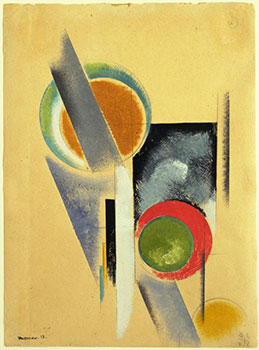
Opening of Pictorial Space and Suprematism


W. Burtin, Advertising Design,
Ref: https://circulatingnow.nlm.nih.gov/2018/11/29/
scope-magazine-1941-1957/
As photographic technology advanced and cameras became popular, realistic art declined in relevance and the artist had more opportunity and freedom to think non-objectively.
For example, art movements like Suprematism, invented by Russian artist Kazimir Malevich, explored the spatial surface of the two-dimensional canvas. Malevich strongly emphasized that an artist mustn’t under any circumstances imitate, but only be innovative – a revolutionary idea that went against the general practice of art schools. Suprematist artists used a limited color scheme and artfully arranged geometric forms in the pictorial plane. They created dynamism and heightened tension by overlapping vertical, horizontal, or diagonal objects. The edge of the canvas represented infinite space. Spatial experience was conceived only abstractly. As Malevich stated:
“We must devote ourselves directly to the masses of color as such and look for the decisive forms in them. The movement of the red, green and blue masses cannot be reproduced by the representative drawing. This dynamism is no more than a revolt of the pictorial masses to become independent of the object, to be freed from the forms that designate nothing, that is to say, to make purely pictorial forms predominate over rational forms, to arrive at Suprematism, new realism of painting.”

Space construction on pictorial surface:
Aleksandr Rodchenko Composition 1918.

Space construction on pictorial surface:
Aleksandr Rodchenko Composition 1919
Picture Courtesy of the Museum of Modern Art
Machines inspired the overlapping free-floating planes of their solid compositions. They looked to machines not only for inspiration in the shapes created, but also in the arrangement of these elements. Suprematist designs were constructed in a similar fashion to machine constructions, in which objects overlapped and interpenetrated.
The open construction style and new materials, such as glass and steel frames, of new buildings also inspired the Suprematists. In this way, a dynamic open space with solid, transparent, and interconnected surfaces appeared in the art-world.
Later, Suprematist aesthetics were adopted in printing advertisements and flyers. The message in advertisement was conveyed using basic geometric shapes and every extra detail was eliminated. The reader’s eye is guided in these images by basic shapes, colors, and lines around a diagonal axis.
Brinda Pamulapati, owner/managing director, of Venvi Art Gallery in Tallahassee, can be reached at (850) 322-0965 or visit www.VenviArtGallery.com